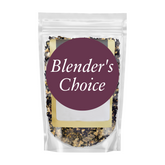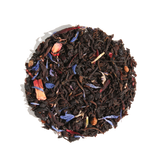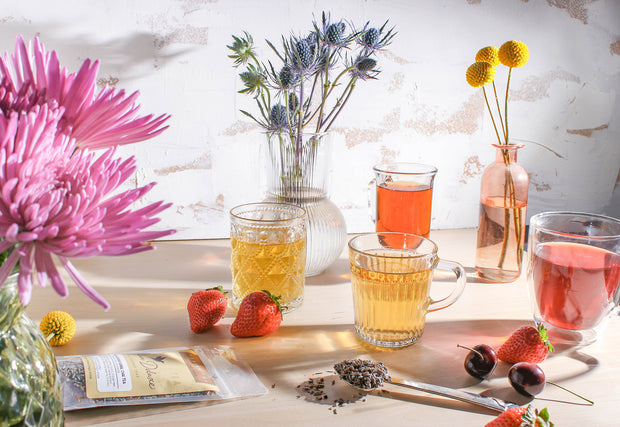When my nephew brought a friend to visit and tour Alaska, his friend brought me three brightly checked tea towels. You would not believe how much I love them. (Hint: it’s a lot!)
Not only are the towels useful—but they cover rising bread, dry dishes, insulate cooling jam jars, drain blanched vegetables for freezing, and so on.
They make me happy, snugly rolled in the drawer or taking a turn on the oven handle, bright and cheerful, reminding me of good people and a grand adventure. I think that’s a great way to say “thank you."

But what is a Tea Towel, Exactly?
According to the Oxford English Dictionary, a tea towel is “a cloth for drying washed crockery, cutlery, and glasses.”
Historically, they were also called glass towels, damask toweling (referring to a patterned weave), and crash toweling (referring to a coarse, loosely-woven fabric). In North America, we often say “dish towel.”
That’s a serviceable definition, but the history of tea towels tells a story much more involved and interesting than that of a cloth drying dishes.

More than a Drying Cloth
I chose the Oxford definition because the transformation of standard kitchen towels to more elegant tea towels occurred in 18th-century England when simple household teas were elevated to social events that demanded fine tea sets and table settings.
The Victorian era, with its emphasis on social classes, status symbols, and leisure activities ushered in a household-linen hierarchy with tea towels rising above their normal kitchen station.
During this time, the towels were hemmed by hand. The even-weave fabric lent itself to fancy and decorative hemstitching as well as other embroidery, and tea towels became canvases on which to practice and display needlework, coordinating with tablecloths and serviettes (napkins).

Linen vs Cotton
In England, tea towels were originally made of flat-woven linen, a natural fiber made from flax plants. They were used to dry delicate china and tea sets, as the Oxford definition suggests.
Table and household “linens” got their name from the fabric, and we continue to use it, regardless of the fabric in the textiles.
As cotton became readily available, particularly here in the US, it became the fabric of towels and other household linens. Cotton is softer and a smidge more absorbent than linen, but depending on the length of the cotton fibers, some cotton towels can shed more lint than linen.
Linen, however, is more durable, so it stays in better shape over time, and it softens with use. Nowadays, tea towels might be cotton, linen, or cotton-linen blends.
Terry cloth towels, with their thirsty, looped-cotton threads, may be called hand towels or dish towels, but they are not tea towels. While absorbent, terry towels tend to shed lint.

Mass-produced Tea Towels
The Industrial Revolution increased the production of fabric, and tea towels, like all household linens, were mass-produced, driving down prices and making them available to everyone. In the 1920s and 30s, towels were mostly white or had a colored stripe along the edges.
During the Great Depression, resourceful Americans repurposed cotton sacks that packaged flour, sugar, feed, and more.
They sewed, hemmed, and embroidered them into clothing, diapers, dishcloths, and, yes, tea towels. Flour companies supported the trend by producing flowered and patterned packaging with their logos printed in ink that could be washed out of the fabric.
Today, flour and sugar come in paper packaging, but “flour sack” towels have become a thing unto themselves, a particular kind of cotton tea towel.

Printed Tea Towels
When World War II was over and attention focused again on home life, decorative printed tea towels entered a heyday.
Flowers, fruits, vegetables, animals, sayings, maps, calendars...you name it, you could probably find it printed on a tea towel. They became popular gifts and souvenirs for travelers.
Looking closely at my stash of tea towels, I realize that every single one was a gift or a hand-me-down—otherwise known as a family heirloom. I called my mother to ask about her tea towels, and in her case too, every one was a gift. Where or how or from whom did you get your tea towels?
If you’re someone who keeps a secret stash of "for-anyone" gifts for last-minute gift-giving, consider stocking up on tea towels. They’re fun to browse and easy to store. And you know what makes them even better? Being paired with some Plum Deluxe tea!

Tea Towel Trivia
The straightforward Oxford answer to the question of what is a tea towel is not inaccurate, but it belies the varied uses and storied history of the textile and its place in culture. For instance, Victorian needleworkers and depression-era housewives were not the only ones to get creative with tea towels.
Dutch Impressionist painter, Vincent Van Gogh, painted his first version of Daubigny’s Garden on a tea towel. The backside of the work reveals telltale red stripes woven into the fabric along two edges.
Two still lifes of flowers in vases were also painted on similar fabrics with red borders, one of which sold at auction in 2000 for over two million pounds. And there were more: two paintings made during his stay at a mental asylum were painted on table cloths or tea towels.
If anyone wants to make a gift of a Van Gogh tea towel...my birthday is coming!

![Spring Break Tea Variety Pack [6-Pack Variety of Flavors]](http://www.plumdeluxe.com/cdn/shop/files/spring-break-pack.jpg?v=1740682266&width=165)















